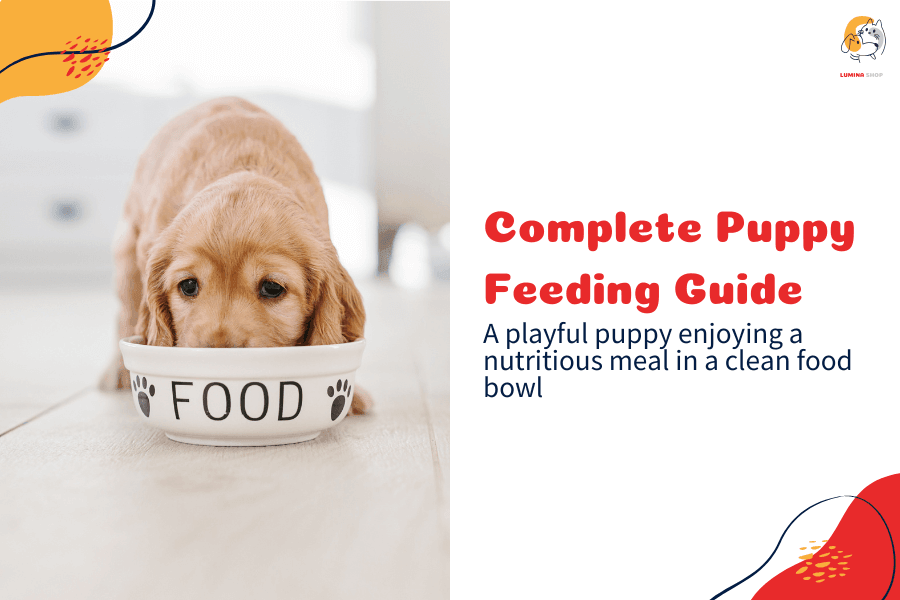
Puppy Feeding: How Often & What to Feed?
Feeding your puppy the right amount and type of food is crucial for their growth, energy, and overall health. But how often should you feed them? And what’s the best food for their development?
In this guide, we’ll cover the ideal feeding schedule by age, portion sizes, and the best types of food to keep your puppy happy and healthy.
Recommended Product:
High-Quality Puppy Food – Packed with essential nutrients for your growing pup.

1. How Often Should You Feed Your Puppy?
Puppies have small stomachs and fast metabolisms, so they need frequent meals throughout the day. The feeding schedule depends on their age:
| Puppy Age | Meals Per Day |
|---|---|
| 8-12 weeks | 4 meals per day |
| 3-6 months | 3 meals per day |
| 6-12 months | 2 meals per day |
At 12 months, most dogs transition to one or two meals per day, depending on their breed and activity level.
Recommended Product:
Slow Feeder Bowl – Helps prevent fast eating and digestion issues.

2. How Much Should You Feed Your Puppy?
Portion sizes vary based on breed, weight, and food type. Always follow the feeding guidelines on your puppy food packaging and consult your vet for exact amounts.
🐶 General Feeding Guidelines by Weight:
| Puppy Weight | Daily Food Amount |
|---|---|
| 5 lbs (2.3 kg) | 1/2 cup – 1 cup |
| 10 lbs (4.5 kg) | 3/4 cup – 1.5 cups |
| 20 lbs (9 kg) | 1.5 – 2.5 cups |
| 50 lbs (23 kg) | 2.5 – 4 cups |
Pro Tip: Large breed puppies need special food to support joint and bone health.
Recommended Product:
Large Breed Puppy Food – Formulated for healthy growth in large dogs.

3. What Type of Food Is Best for Puppies?
Puppies need high-quality, nutrient-rich food to support their development.
🥩 Dry Kibble: Convenient and promotes dental health.
🥫 Wet Food: Higher moisture content, great for hydration.
🍗 Raw or Fresh Food: Natural but requires careful balance.
Key Nutrients to Look For:
✔ Protein – Supports muscle growth.
✔ Healthy Fats – Boosts brain development.
✔ Calcium & Phosphorus – Strengthens bones and teeth.
✔ DHA & Omega-3s – Supports vision and cognitive function.
Recommended Product:
Nutrient-Rich Puppy Treats – Perfect for training and rewarding good behavior.

4. When to Transition to Adult Dog Food
Most puppies switch to adult food around 12 months, but large breeds may need puppy food for up to 18-24 months. Transition gradually over 7-10 days to avoid stomach upset.
🚀 Transitioning Steps:
1️⃣ Mix 75% puppy food + 25% adult food for 2-3 days.
2️⃣ Gradually increase adult food while decreasing puppy food.
3️⃣ By day 7-10, your pup should be fully on adult food.
Recommended Product:
Adult Dog Food – Tailored nutrition for healthy adult dogs.

5. Signs You Need to Adjust Your Puppy’s Diet
🐾 Underfeeding Signs:
- Visible ribs and spine
- Low energy levels
- Slow growth
🐾 Overfeeding Signs:
- Rapid weight gain
- Frequent digestive issues
- Lethargy after meals

Conclusion
A proper feeding schedule and balanced nutrition are essential for a puppy’s health. Feed them small, frequent meals, choose high-quality food, and adjust portions as they grow.
For premium puppy food and feeding essentials, visit Lumina Pet Shop.
Feed smart, grow strong! 🐶🥣
